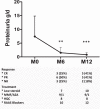Proliferative lupus nephritis in the absence of overt systemic lupus erythematosus: A historical study of 12 adult patients
- PMID: 29310419
- PMCID: PMC5728820
- DOI: 10.1097/MD.0000000000009017
Proliferative lupus nephritis in the absence of overt systemic lupus erythematosus: A historical study of 12 adult patients
Abstract
Severe lupus nephritis in the absence of systemic lupus erythematosus (SLE) is a rare condition with an unclear clinical presentation and outcome.We conducted a historical observational study of 12 adult (age >18 years) patients with biopsy-proven severe lupus nephritis or lupus-like nephritis without SLE immunological markers at diagnosis or during follow-up. Excluded were patients with chronic infections with HIV or hepatitis B or C; patients with a bacterial infectious disease; and patients with pure membranous nephropathy. Electron microscopy was retrospectively performed when the material was available. End points were the proportion of patients with a complete response (urine protein to creatinine ratio <0.5 g/day and a normal or near-normal eGFR), partial response (≥50% reduction in proteinuria to subnephrotic levels and a normal or near-normal eGFR), or nonresponse at 12 months or later after the initiation of the treatment.The study included 12 patients (66% female) with a median age of 36.5 years. At diagnosis, median creatinine and proteinuria levels were 1.21 mg/dL (range 0.5-11.6) and 7.5 g/day (1.4-26.7), respectively. Six patients had nephrotic syndrome and acute kidney injury. Renal biopsy examinations revealed class III or class IV A/C lupus nephritis in all cases. Electron microscopy was performed on samples from 5 patients. The results showed mesangial and subendothelial dense deposits consistent with LN in 4 cases, and a retrospective diagnosis of pseudo-amyloid fibrillary glomerulonephritis was made in 1 patient.Patients received immunosuppressive therapy consisting of induction therapy followed by maintenance therapy, similar to treatment for severe lupus nephritis. Remission was recorded in 10 patients at 12 months after the initiation of treatment. One patient reached end-stage renal disease. After a median follow-up of 24 months, 2 patients relapsed.Lupus nephritis in the absence of overt SLE is a nosological entity requiring careful etiological investigation, including systematic electron microscopy examination of renal biopsies to rule out fibrillary glomerulonephritis. In this series, most patients presented with severe glomerulonephritis, which was highly similar to lupus nephritis at presentation and in terms of response to immunosuppressive therapy.
Conflict of interest statement
The authors have no conflicts of interest to disclose.
Figures


References
-
- Hochberg MC. Updating the American College of Rheumatology revised criteria for the classification of systemic lupus erythematosus. Arthritis Rheum 1997;40:1725. - PubMed
-
- Ruggiero B, Vivarelli M, Gianviti A, et al. Lupus nephritis in children and adolescents: results of the Italian Collaborative Study. Nephrol Dial Transplant 2013;28:1487–96. - PubMed
-
- Huerta A, Bomback AS, Liakopoulos V, et al. Renal-limited “lupus-like” nephritis. Nephrol Dial Transplant 2012;27:2337–42. - PubMed
-
- Sharman A, Furness P, Feehally J. Distinguishing C1q nephropathy from lupus nephritis. Nephrol Dial Transplant 2004;19:1420–6. - PubMed
Publication types
MeSH terms
Substances
LinkOut - more resources
Full Text Sources
Other Literature Sources
Research Materials
Miscellaneous

